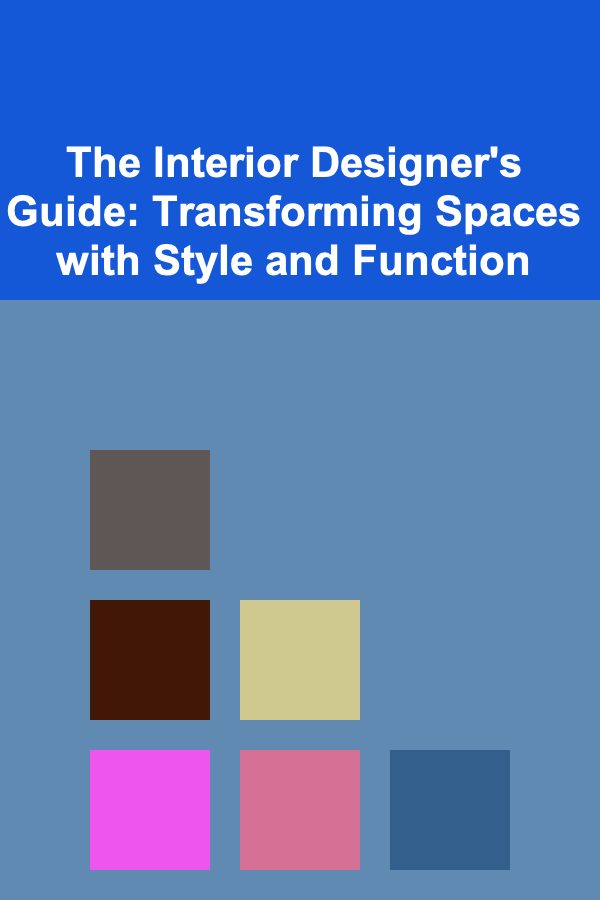
The Interior Designer's Guide: Transforming Spaces with Style and Function
ebook include PDF & Audio bundle (Micro Guide)
$12.99$10.99
Limited Time Offer! Order within the next:

Interior design is more than simply arranging furniture in a room---it's about creating spaces that are functional, aesthetically pleasing, and reflective of personal style. Whether you're an aspiring interior designer or someone who enjoys enhancing the spaces they live in, understanding the key principles and strategies that define great interior design can help you transform any room into a stylish, functional environment. This guide explores these principles, offering actionable advice on how to achieve interiors that impress and serve.
Understanding the Basics of Interior Design
Before diving into design specifics, it's important to understand the foundational principles of interior design. These principles serve as the framework through which style and function can be harmonized in a space.
The Core Principles of Design
-
Balance: Just like a well-balanced meal, a well-balanced room includes a variety of elements that feel equally distributed. Balance can be achieved in three ways:
- Symmetrical balance: When elements on either side of a central axis are mirrored, creating a formal, orderly feel.
- Asymmetrical balance: A more relaxed, dynamic balance achieved by using different elements of varying sizes and weights but arranged in a way that feels visually stable.
- Radial balance: Elements arranged around a central point, often seen in circular or oval arrangements.
-
Proportion and Scale: These two principles are about ensuring that objects within a room complement each other in terms of size and shape. The goal is to ensure that items are scaled to the room's size, preventing the space from feeling overcrowded or too sparse.
-
Rhythm: In design, rhythm creates a sense of movement, achieved by repeating colors, patterns, or shapes. This pattern-building approach leads the eye through the space in a cohesive way.
-
Harmony: Harmony ensures that every element of the room fits together, supporting the overall aesthetic. It's the feeling of cohesion and flow that comes when colors, textures, and furniture complement each other.
Creating Functional Spaces
A well-designed space is not only visually appealing but also serves the practical needs of those using it. Functionality should always be at the forefront of any design decision, from layout to furniture choices. Here's how to make your spaces as functional as they are stylish.
1. Plan the Layout: Space Planning
The layout of a room plays a pivotal role in its functionality. Space planning involves arranging furniture and decor in a way that allows people to move freely and use the space effectively.
- Define the Room's Purpose: Each room should have a clear function, whether it's a living room for entertaining, a kitchen for cooking, or an office for working. This purpose should dictate the furniture, layout, and design choices you make.
- Traffic Flow: Consider how people will move through the space. A well-planned layout ensures that there are clear, unobstructed pathways, especially in high-traffic areas like living rooms and kitchens.
- Focal Points: Every room needs a focal point---a piece of furniture, a window with a beautiful view, or a piece of artwork. Arrange furniture around this focal point to create balance and purpose.
Actionable Tip: When planning a layout, keep the room's purpose in mind and aim for balance in the positioning of furniture. Use rugs and furniture placement to define different areas within an open space.
2. Ergonomics: Comfort Meets Design
Ergonomics is about designing furniture and spaces for comfort and usability. For example, the height of a chair, the distance between a sofa and the coffee table, and the angle of lighting all contribute to how comfortable and functional the space will be.
- Furniture Selection: Choose furniture that is not only stylish but comfortable. Look for pieces that offer proper support and allow for easy movement within the room.
- Lighting: Proper lighting is crucial for functionality. A well-lit space is more inviting and easier to navigate, whether it's task lighting for reading or ambient lighting for a relaxing atmosphere.
Actionable Tip: Always prioritize comfort when choosing furniture. Test the seating arrangements to ensure they're comfortable for the users, and adjust lighting to create different moods depending on the room's needs.
Creating a Stylish Environment
Aesthetics are a key part of interior design. Style is often what gives a room its character, so the goal is to mix personal preferences with timeless design principles. Here are the top strategies for ensuring that your space is both stylish and enduring.
1. Color Theory: Set the Mood with Color
Color is one of the most powerful tools in interior design. It can influence the mood of a space and make rooms feel either expansive or cozy. Understanding color theory helps you select the right palette for each room.
- Neutral Colors: Neutrals like whites, grays, and beiges create a calming, timeless backdrop for any space. They allow other design elements, like furniture or artwork, to stand out.
- Bold Colors: Bright or dark colors can inject energy and drama into a space. Consider using bold colors on accent walls, furniture, or accessories.
- Color Schemes: The color wheel can help you create harmony. Monochromatic schemes (variations of one color) create serene and cohesive spaces, while complementary (opposite colors) and analogous (adjacent colors) schemes can create dynamic contrasts.
Actionable Tip: Start with neutral tones for walls and larger furniture pieces, then use pops of color through smaller items like cushions, curtains, or artwork.
2. Layering Textures: Depth and Warmth
Texture is just as important as color when it comes to creating a stylish space. Mixing textures in a room adds depth, warmth, and interest. A room with only smooth surfaces may feel cold and sterile, whereas the combination of textures can make the space feel more inviting.
- Soft Textures: Incorporate textiles such as velvet, linen, and cotton through furniture, curtains, and throw pillows to soften hard surfaces.
- Hard Textures: Use materials like wood, stone, glass, and metal to create a sense of contrast and sophistication.
- Balance: Too much texture can overwhelm a space, so balance tactile elements by mixing soft and hard textures in an organized way.
Actionable Tip: Use soft textures like plush rugs, velvety cushions, and woven throws to contrast against harder surfaces such as metal light fixtures, glass tables, and wooden furniture.
3. Furniture and Decor: Crafting Style with Purpose
Furniture and decor are the backbone of any room's style. These items should not only contribute to the room's aesthetic but also be selected with purpose.
- Furniture Selection: Choose furniture that complements the style of the room but also functions for your lifestyle. For example, an antique-style dresser may add charm to a bedroom, while a modern sofa offers sleek lines and comfort to a living room.
- Decor Items: Accessories like artwork, lighting, and small decor items personalize a space. Don't overcrowd the room with too many trinkets; instead, focus on a few statement pieces that enhance the room's personality.
Actionable Tip: Focus on statement pieces of furniture that blend style with function, such as an elegant dining table or a comfortable yet chic sectional. Use decor items sparingly to avoid clutter.
Personalizing the Space
Personal touches make a house feel like a home. Personalization ensures that the space reflects the unique tastes, interests, and personalities of those who live there.
1. Artwork and Photography: Add Character
Art is an expression of personality, and it's one of the easiest ways to personalize a space. From large statement pieces to smaller curated collections, artwork and photography help reflect the room's theme and the homeowner's style.
Actionable Tip: Hang artwork at eye level for optimal viewing and ensure it complements the overall color scheme and aesthetic of the room. Mix framed prints with unique objects like sculptures or woven tapestries for added personality.
2. Sentimental Objects and Heirlooms
Incorporating sentimental items or heirlooms gives a space emotional depth. Whether it's a family heirloom, travel souvenirs, or personal collections, these items provide a sense of history and warmth.
Actionable Tip: Display heirlooms or meaningful objects as part of the room's decor. Showcase them in a curated way on shelves, mantels, or side tables to add layers of personal meaning to the design.
Conclusion: Bringing It All Together
Transforming a space into something functional and stylish involves a delicate balance between planning, creativity, and a deep understanding of design principles. By considering functionality, style, and personalization, you can create rooms that not only look great but also serve the needs of the people who use them.
Remember, interior design is an evolving process that takes time and consideration. By mastering the key aspects of layout, color, texture, and personalization, you can craft spaces that are both practical and aesthetically pleasing---spaces that will stand the test of time.

How to Create and Sell Deep Learning Algorithms for Continuous Revenue
Read More
How to Decorate Your Home for Spring with Budget-Friendly Ideas
Read More
How to Ensure Your Rental Property Is Accessible to People with Disabilities
Read More
How to Evaluate Your Kitchen Needs Regularly for Improvements
Read More
How to Organize Your Personal Records for Easy Retrieval
Read More
How To Plan a Solo Hiking Trip
Read MoreOther Products

How to Create and Sell Deep Learning Algorithms for Continuous Revenue
Read More
How to Decorate Your Home for Spring with Budget-Friendly Ideas
Read More
How to Ensure Your Rental Property Is Accessible to People with Disabilities
Read More
How to Evaluate Your Kitchen Needs Regularly for Improvements
Read More
How to Organize Your Personal Records for Easy Retrieval
Read More